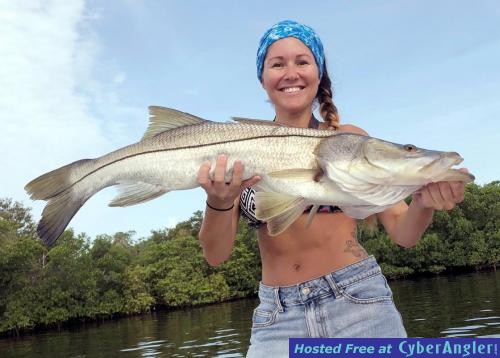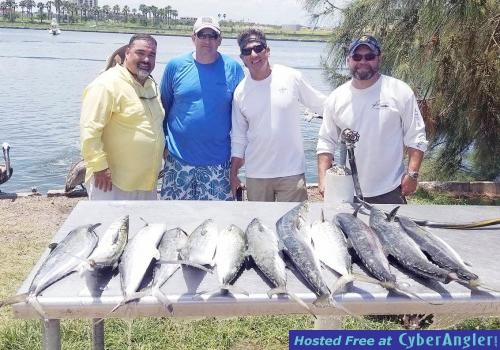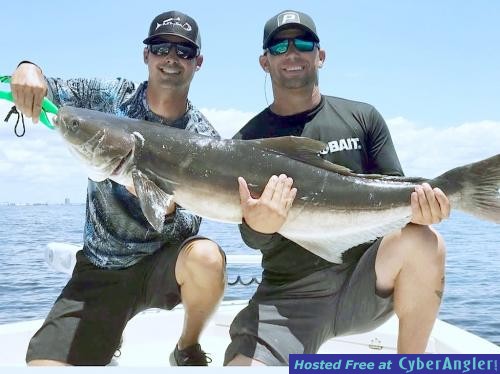Tampa Bay's August Fishing Report 2018
Capt. Woody Gore
July 5, 2018
Tampa Bay - Saltwater Fishing Report

Comfort is paramount to all species and water temperature is a major factor because of its governing effect on a fish's bodily functions.

Have you ever questioned why fish congregate in one particular area one day and completely disappear, the next? Various circumstances might cause fish to relocate, but probably the most overlooked is water temperature. Whereas fish being cold-blooded, weather and water temperature is a controlling factor in finding them one day and not the next. Every species has a comfortable temperature range. They tend to tolerate temperatures within that preferred range or comfort zone. If that preferred temperature range changes too much the fish may relocate to a more appropriate temperature or become inactive until they find a more suitable temperature zone.
Understanding temperature change and its affects is important to your fishing trip. As water temperatures change; either exceeding high or dropping below a species particular comfort range, they become non-responsive and lethargic. But by understanding their comfort tolerances goes a long way toward selecting the right location, time of day, bait or lure. For example, water temperatures dropping in the low 60's puts spotted sea trout in high spirits, but becomes very disconcerting to snook, redfish, and tarpon. On the other hand, temperatures in the low to mid 80's are fine for snook, redfish and tarpon. When water temperatures reach into the 90's as is often the case in Tampa Bay you might begin searching out deeper cooler waters.
How fish react to today's temperature often depends on the temperature it was exposed to yesterday, and even some days before. Gradual temperature changes over several days or weeks frequently result in better long-term fishing, while rapid changes now and then stimulate only a strong short-term bite.
Snook, Redfish & Spotted Sea Trout: Clear skies and hot summer days allow the suns thermal energy to quickly penetrate the waters on Tampa Bay's broken bottom shallow grass flats; allowing the bottoms to become much warmer than the white sandy areas. The difference between dark and white bottoms may only be one or two degrees, but it can make a difference when you're looking for happy comfortable fish. As water warm and temperatures rise you'll not likely find snook, redfish or trout in skinny water, except perhaps early in the mornings or late night. Depending on the temperatures they transition between deep and shallow water depending on bait movement.

Many times you'll find them suspending at different levels depending on the thermoclines or chasing bait along a shallow shade line of the mangroves. (Heather Overstreet found this giant cruising the mangrove shade line along the southeast shore, she temped it with a fresh greenie and look what happened. Nice catch Heather.)
You will find snook, redfish and trout in Tampa Bay from the southeast shore to the Alafia River, Picnic Island, Simmons Park, Bishop Harbor, Joe Island down into Bradenton and Sarasota. Also, there's some excellent fishing around Weedon Island, Fourth Street, Cypress Flats, Rocky Point, Double Branch, and Culbreath Isle Flats.
This time of year greenbacks seem to be the bait of choice. Other baits that also work are threadfins, pinfish, chunked ladyfish and the old standby live shrimp. For those catching their own greenbacks, they are all over the grass flats and markers. The only drawback is throwing that blasted cast net. During these hot water days when you can see the fish, but they just don't want to eat. Try a slow reel presentation using a nose hooked greenback; often this triggers the fish to strike. It's worked for me for many years.
Check the deeper passes separating the Mangrove islands. Early mornings are great times for artificial lures. It seems like I'm constantly talking about artificial lures and folks ask me why? It's actually simple Artificial lures simply exhilarating and exciting. Basically it's the true measure of an angler's ability to consistently deceive fish into striking a non-natural food source. The key points to artificial lure fishing are patience, proficiency followed by personal confidence. Then soon you'll find yourself relaxing with a nice artificial lure, while anxiously anticipating the next heart stopping strike of a snook, redfish or trout.
Snook: Found in canals, tidal creeks, and other deep, warm waters in cool months; near tidal passes, deeper broken bottom grass flats and mangrove fringes at high tide in warmer times of the year. Use live pinfish, small mullet, shrimp, or sardines free-lined or fished with a bobber or use jigs and minnow-like lures. Beware of the razor-sharp gill plates.
Spotted Seatrout: Found in seagrass beds when water temperatures are moderate and in deeper waters adjacent to broken bottom grass beds during both the warmest and coolest months. Use live shrimp, small pinfish, greenbacks or pigfish (grunts) fished near the bottom by free-lining or under a popping bobber, or use soft-bodied and fish like lures. You can also cast with jigs or surface plugs as you drift.
Redfish / Red Drum: Found near docks and pilings, schooling on broken bottom grass flats, deeper holes and channels during the warmest and coolest months; around grass beds and oyster bars. Try using sardines, live shrimp, or cut bait fished on bottom or free-lined, or use soft-bodied jigs bounced slowly along the bottom. Then there are always the old standby gold spoons.
Mackerel fishing in Tampa Bay is strong. There are some giant drag screamers chasing schools of threadfins. These are some of the most exciting fish you'll ever catch on light tackle with the larger ones average from 3 to 5 pounds. (Here's a photo of a few huge mac's my good friend Capt. George lead his clients to last month.

Talk about drag screamers!) They hit hard, rip off 20 to 30 yards of line, and make you wonder what's on the end of my line. It's simple to do just find some hard bottom or a marker, or just look for birds diving on feeding fish and you're set. Toss out a bag or two of chum and get ready for some rod bending light tackle action. Try using greenbacks or threadfins with small wire leaders and long shank hooks. I use 50# Seaguar Fluorocarbon leader, long shank hooks. Mackerel are excellent table fare, but it's important to immediately bleed and eviscerate them. Then put them on and on ice. Fillet them and place on the grille with lemon juice and garlic salt and in about ten to 15 minutes their ready.
Mangrove Snapper It's that time of the year; they're here, are fairly easy to catch and are found on every rock pile or structure around Tampa Bay. Light line and smaller hooks should produce a nice grey snapper meal. They're really partial to the new hatch greenies or threadfins but always love shrimp. Use a chum bag or better yet chop up some of the small greenies or threads and toss them in the current and hang on to your rod and reel.
Note: This is new this year: All Gulf Reef Fish Anglers are required to sign up for the Gulf Reef Fish Survey. Snapper and Gag Grouper in in Tampa Bay are still considered Reef Fish and must be reported on the gulf survey. http://myfwc.com/fishing/saltwater/recreational/gulf-reef-fish-survey/
Cobias seems like they are showing up around the bay more often this year than last we're finding them holding around markers especially those with bait or cruising, the grass flats following large rays or manatees. When fishing markers, keep a chum bag over the side, if they're in the area it should attract them. Toss them a pinfish, greenback or threadfin and hold on.

(Here's a fifty-one pounder caught by Capt.'s Kevin on the right and Glenn in Tampa Bay, while fun fishing together.)
Tarpon fishing might slow a bit in August as many are returning from offshore. However, fishing around the bay area usually continues with resident fish haunting the light-lines around the bridges. The best fishing seems to be at night or early in the mornings and fairly easy to sight cast, but difficult to land (bridge pilings).
Give Me a Call & Let's Go Fishing – 813-477-3814 The area's top outdoor fishing guide service, Captain Woody Gore has guided and fished the Tampa, St. Petersburg, Clearwater, Tarpon Springs, Bradenton, and Sarasota areas for over fifty years; his charters offer world class fishing adventures and a lifetime of memories.
Single or Multi-boat Group Charters are all the same. With years of organizational experience and access to the areas most experienced professional guides and captains, I can arrange and coordinate any outing or tournament. Just tell me what you need and it's done. For more information please visit my website at: www.captainwoodygore.com, or email me at [email protected] or give him a call at 813-477-3814.
Target Species:

Snook, Trout, Redfish, Cobia, Spanish Mackerel, Tarpon
More Fishing Reports:


